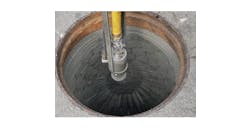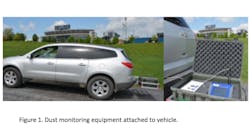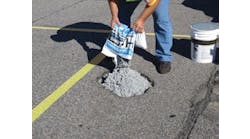The use of warm-mix asphalt (WMA) has grown rapidly in the short time it has become a familiar acronym in the U.S. In fact, the Ohio Department of Transportation (ODOT) placed 2.8 million tons of water-injected WMA in 2011.
But, ODOT’s WMA work has not advanced without concerns, questions and research.
The reality of WMA is that it just happens to be a promising improvement to an entire industry at an opportune time. However, numerous questions surround WMA: How does WMA perform given the variety of WMA techniques; what is the long-term performance of WMA; how will WMA affect construction approaches? In spite of these questions the potential benefits of WMA are more than sufficient to justify giving it a good, hard look. For most agencies, specification changes often occur in unpredictable ways: sometimes in very slow increments and sometimes in overnight chaos. Engineers, of course, prefer predictability as that is how they are trained. Such is not always the world we live in though and reality has to be dealt with.
In Ohio, the asphalt-paving association, Flexible Pavements of Ohio (FPO), approached ODOT in early 2006 with a desire to evaluate WMA, at first for its potential worker-safety benefits, but certainly for its other potential benefits. A national Federal Highway Administration (FHWA) technical working group had recently established a very extensive list of data needed to give WMA a proper look. Very quickly a project was designed that included well-known WMA products at the time: Sasobit, Evotherm and Aspha-min. Additional research and data collection was incorporated into the project, and the project was successfully completed in September 2006.
From this project ODOT decided to look at a new approach to an old technology, foamed asphalt, which was quickly advancing nationally as a WMA alternative. Six foamed asphalt water-injection trial WMA projects were planned for 2008 with an eye to data collection for emissions, moisture-damage potential and quality-control issues. From these projects ODOT hoped to determine with more definition what durability issues might exist with WMA, as at first glance combining water and asphalt is not usually viewed as good.
Given the speed of trial work and potential benefits things at ODOT were about to heat up. In early 2008, FPO invited then ODOT Director James Beasley to a viewing of the plant operation for water-injected WMA. From that meeting a decision was made to move ahead with WMA implementation in all ODOT asphalt work. This implementation has progressed rapidly, and in 2011 56% of total ODOT asphalt tonnage was WMA by water injection.
Following the 2008 WMA trials, specifications were developed allowing WMA, but it was restricted from heavy-traffic surfaces. This was partly done to allow a learning period for producers and crews before using WMA on our most heavily traveled routes. The next season this restriction was lifted. Today ODOT specifications allow WMA as an alternative to HMA, provide plant requirements for water-injection units and stipulate how compaction testing is to be performed for quality control.
Heated activity
Some might say ODOT is out on a long limb with WMA, and there are valid arguments against rapid implementation of it. However, with all the data considered, trials evaluated and lack of project failures ODOT appears to be on the right track. It must be admitted that no field fully answers all questions before implementing ideas.
ODOT’s first WMA research project in 2006 was designed to learn as much as possible—quickly. In addition to the three trial sections and one control section, WMA was placed at Ohio University’s indoor loaded-wheel facility. This work studied rutting of those mixes as well as collecting perpetual pavement data in the full-depth sections. The research produced some interesting conclusions:
The four different sections of ODOT’s first WMA project, GUE-541, showed no obvious differences in visual inspection after 20 months (now five years) of service;
The laboratory measurements of indirect tensile strength indicated no significant difference between the WMA mixes and the HMA control mix;
Emissions at the paving site of total particulate matter for all three warm mixes were 67-77% less than those for the HMA control mix. Emissions of benzene soluble matter were decreased by 72-81% relative to the HMA; and
In the APLF, all three of the WMA surfaces experienced more consolidation than the HMA control surface during the initial stages of application of the wheel load. After the initial consolidation, further consolidation of each pavement was about equal.
The report of research from this project can be found in the study Performance Assessment of Warm Mix Asphalt (WMA) Pavements on ODOT’s website. In addition to ODOT’s research, the National Center for Asphalt Technology (NCAT) conducted research on Ohio’s first WMA project. NCAT had its test trailer on-site for the project and numerous samples were tested. NCAT published a report of this work, titled Ohio Field Trial of Warm Mix Asphalt Technologies: Construction Summary, which offers some useful and positive conclusions and is available on NCAT’s website.
In 2008, ODOT set up six trial projects for WMA by water injection. These trial projects included control sections of HMA, one method of water injection, multiple mixture types and multiple contractors and plants. Data collection from these WMA trials produced the following conclusions:
The projects were successfully placed with minimal disruption and are performing well today;
Both polymer and nonpolymer mixes were successfully placed;
WMA can act as a compaction aid;
The WMA can be placed 30-40ºF lower in temperature compared with HMA;
The data showed a drop in tensile strength ratio but values passed minimum specification limits;
Emissions values measured at the plant were nearly all lower but are heavily influenced by plant burner efficiency at the lower operating temperature; and
For projects with much hand work higher placement temperatures may be needed.
Current ODOT research is taking a closer look at understanding the mechanisms and limitations of water injection for foaming asphalt. ODOT has completed a recent study looking at WMA by foaming in the laboratory. The goal of this work was to understand if WMA could be replicated in the laboratory for design and further research purposes.
In addition ODOT has recently started two studies looking at foaming. The first, The Use of Atomic Force Microscopy to Evaluate Warm Mix Asphalt, will consider a measurement technique that will on a nano scale better explain what exactly happens in an asphalt binder as water creates vapor pockets that in turn collapse upon cooling. Particularly of interest is the healing that takes place in binders and the effect of the vapor pocket process on the moisture-damage potential of WMA mixes. Secondly, a more extensive study involving two universities is looking at the limitations of WMA by water injection as it affects design, quality control and placement of mixes. This study also will look at the moisture-damage potential in WMA compared with HMA but will consider the amount of water injected to create foamed asphalt and the effect on production and placement. All of this research has a goal of understanding the degree of potential risks with WMA, particularly with regard to long-term asphalt-pavement performance.
Nothing unusual
Since the first WMA trial in 2006 nearly 4.9 million tons of WMA have been successfully placed in Ohio. In 2011, 2.8 million tons (56% of total production) of WMA were placed. There have been very few placement problems that are attributable to WMA. A few construction issues are noteworthy:
Some crews like to increase the temperature above what water-injected WMA typically targets as they have found ease of compaction and lower emissions at the paver;
In a couple of instances, projects have reported a minor “sheen” on the surface of newly placed WMA that is not as severe as a flushed pavement. The sheen quickly dissipated under traffic. While not fully understood it is believed the sheen is related to higher moistures in the mix and short haul distances. Avoiding over-compaction helps control the sheen appearance; and
In a couple of instances, rough-looking hand work areas or smoothness issues have been noted. These are avoidable with proper contractor control of trucks and compaction temperature.
Although it is admittedly early, so far there are no projects exhibiting unusual damage, including unusual rutting, moisture damage or raveling, that are attributable to WMA.
According to specification
In section 401.05 of ODOT’s 2010 Construction and Material Specifications is this simple sentence: “Asphalt mixtures may be produced using warm mix asphalt method according to 402.09 except as restricted by specification.” Section 402.09 outlines requirements for water-injection equipment used at asphalt plants. (To date ODOT has seen seven different water-injection systems. Currently 83 of 141 asphalt plants have been outfitted with approved water-injection systems.) Per general specifications in ODOT Construction and Material Specifications, contractors can propose to ODOT for consideration WMA alternatives to these requirements.
For WMA asphalt-mixture design, contractors submit for approval a WMA design per existing HMA design procedures. For quality control of WMA, specimens for air voids are to be compacted at 30ºF less than the design-compaction temperature. ODOT has found this, in general, has worked well. There have been some occasional quality-control issues noted with regard to lower air voids. This can occur when a high absorptive aggregate is used. Simply put, absorption of binder is sometimes slightly less with WMA production than with the HMA design resulting in slightly lower air voids in quality-control testing. The extent of this issue is not known well enough to justify changing current specifications, but is being kept in mind as more knowledge is gained.
There is a tremendous amount of national and state research currently being conducted or planned to address numerous questions surrounding WMA production, design and performance. In addition, research is under way to provide understanding of WMA in more fundamental ways such as the mechanics of foaming and what is considered optimal for producing successful WMA pavements. All of these efforts will produce new approaches and requirements and enable WMA to be placed with greater confidence.
Given that the WMA market will continue to change as newer techniques are tried, and perhaps adopted, it appears ODOT may be in for many years of change in the asphalt industry.Of course, change is nothing new to asphalt users and producers. As agencies appropriately adopt newer approaches the changes expected will be for the best for the taxpayer. AT


